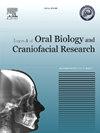Chitosan from sea urchin (Diadema setosum) spines for orthodontic miniscrews: Antibacterial effects against key oral pathogens
Q1 Medicine
Journal of oral biology and craniofacial research
Pub Date : 2025-03-11
DOI:10.1016/j.jobcr.2025.02.014
引用次数: 0
Abstract
Objective
Peri-implantitis, exacerbated microbial growth characterized by progressive bone loss and soft-tissue inflammation, significantly contributes to miniscrew failure during orthodontic treatment. Using a natural antibacterial coating presents an innovative approach to combat bacterial colonization. Sea urchin (Diadema setosum) spines containing chitosan (CS) exhibit notable antibacterial properties and biocompatibility effects. This study investigates the antimicrobial potential of CS from sea urchin spines applied onto the surfaces of orthodontic miniscrews, aiming to mitigate the impact of peri-implantitis.
Materials and methods
The surface functional groups, phase composition, and crystal structure of CS were investigated using traditional examination methods alongside energy-dispersive X-ray analysis. The antibacterial activity of CS was evaluated against three bacteria by the disk diffusion method, minimum bacterial concentration (MBC), and minimum inhibitory concentration (MIC). Stainless steel miniscrews were coated with CS, and the surface was characterized by scanning electron microscopy (SEM).
Results and discussion
Sea urchin-derived chitosan demonstrated significant antibacterial effects against key oral pathogens associated with peri-implantitis, with minimum inhibitory concentrations (MICs) of 16 ppm against Fusobacterium nucleatum and 32 ppm for both Aggregatibacter actinomycetemcomitans and Porphyromonas gingivalis. The minimum bactericidal concentrations (MBCs) were 4 ppm for A. actinomycetemcomitans and 16 ppm for both F. nucleatum and P. gingivalis, indicating its strong bactericidal potential. Scanning electron microscopy (SEM) revealed that sea urchin chitosan effectively adhered to the surface of orthodontic miniscrews, showcasing its potential as a functional antimicrobial coating. These results emphasize the capability of sea urchin chitosan to target key oral pathogens, offering a promising approach to enhance microbial resistance and improve outcomes in orthodontic treatments.

海胆棘壳聚糖用于正畸微型支架:对口腔主要病原体的抗菌作用
目的:种植体周围炎,以进行性骨质流失和软组织炎症为特征的微生物生长加剧,是正畸治疗中微型失败的重要原因。使用天然抗菌涂层提出了一种创新的方法来对抗细菌定植。含有壳聚糖(CS)的海胆棘具有显著的抗菌性能和生物相容性。本研究探讨了海胆棘CS应用于正畸微型支架表面的抗菌潜力,旨在减轻种植周炎的影响。材料和方法采用传统的检测方法和能量色散x射线分析方法对CS的表面官能团、相组成和晶体结构进行了研究。采用圆盘扩散法、最小细菌浓度法(MBC)和最小抑菌浓度法(MIC)对3种细菌进行抑菌活性评价。对不锈钢微螺杆进行了CS涂层处理,并用扫描电镜对其表面形貌进行了表征。结果与讨论海胆壳聚糖对口腔种植体周围主要病原菌具有显著的抑菌作用,对核梭杆菌的最低抑菌浓度为16 ppm,对放线菌聚集菌和牙龈卟啉单胞菌的最低抑菌浓度为32 ppm。放线菌的最低杀菌浓度(MBCs)为4 ppm,核心菌和牙龈假单胞菌的最低杀菌浓度为16 ppm,表明其具有较强的杀菌潜力。扫描电镜(SEM)显示,海胆壳聚糖能有效粘附在正畸微型支架表面,显示了其作为一种功能性抗菌涂层的潜力。这些结果强调了海胆壳聚糖靶向口腔关键病原体的能力,为增强微生物耐药性和改善正畸治疗结果提供了一种有希望的方法。
本文章由计算机程序翻译,如有差异,请以英文原文为准。
求助全文
约1分钟内获得全文
求助全文
来源期刊

Journal of oral biology and craniofacial research
Medicine-Otorhinolaryngology
CiteScore
4.90
自引率
0.00%
发文量
133
审稿时长
167 days
期刊介绍:
Journal of Oral Biology and Craniofacial Research (JOBCR)is the official journal of the Craniofacial Research Foundation (CRF). The journal aims to provide a common platform for both clinical and translational research and to promote interdisciplinary sciences in craniofacial region. JOBCR publishes content that includes diseases, injuries and defects in the head, neck, face, jaws and the hard and soft tissues of the mouth and jaws and face region; diagnosis and medical management of diseases specific to the orofacial tissues and of oral manifestations of systemic diseases; studies on identifying populations at risk of oral disease or in need of specific care, and comparing regional, environmental, social, and access similarities and differences in dental care between populations; diseases of the mouth and related structures like salivary glands, temporomandibular joints, facial muscles and perioral skin; biomedical engineering, tissue engineering and stem cells. The journal publishes reviews, commentaries, peer-reviewed original research articles, short communication, and case reports.
 求助内容:
求助内容: 应助结果提醒方式:
应助结果提醒方式:


